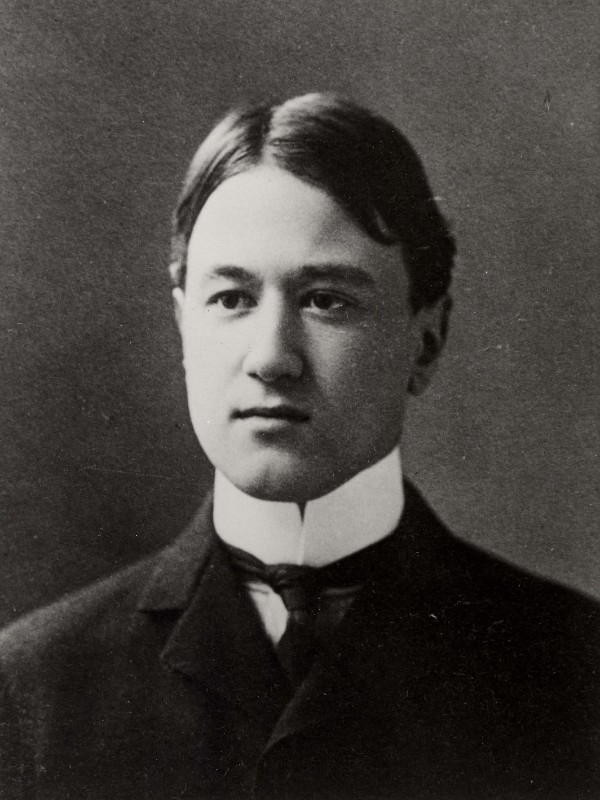The great Czech composer Antonín Dvořák is not really known for his piano music. Standing in the shadows of such masters as Schumann and Brahms, Dvořák’s piano music is nevertheless a significant part of his oeuvre.
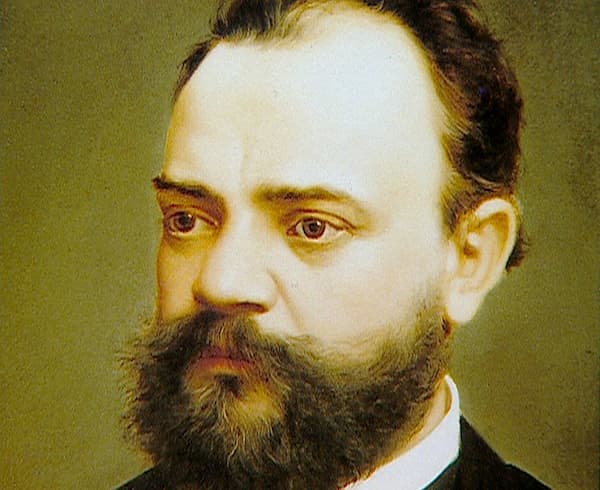
Antonín Dvořák
His solo piano compositions are primarily written for domestic performance and include character pieces, dances, and shorter works that reflect his Czech heritage and Romantic sensibilities. They showcase his lyrical gift for folk-inspired melodies and expose a diverse world of pianistic surprises and subtle timbral effects.
The 13 character pieces that make up the Poetic Tone Pictures, Op. 85 date from 1889, and Dvořák presents himself “not only as an absolute musician, but also a poet.” To commemorate Dvořák’s passing on 1 May 1904, let’s explore these evocative miniatures.
Poetic Musings
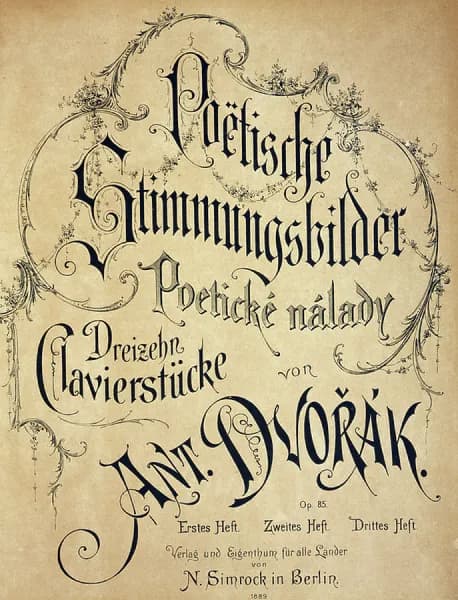
Dvořák’s Poetic Tone Pictures title page
As Dvořák wrote to his publisher Fritz Simrock, “Each piece will have its own title and is meant to express something: thus, as it were, this is program music!” The Poetic Tone Pictures represent a new direction in Dvořák’s style as poetic influences became a dominant part of his musical language.
These pieces were composed at the composer’s summer residence in Vysoká, but to some interpreters, “they represent human situations rather than the landscapes he saw when writing these pieces.” Apparently, the composer himself attached great importance to complete performances of the cycle, although he foretold that “precious few pianists will have the courage to play them one after another… but only thus can the listener form the right picture of that which I may have had in mind.”
Twilight Way
It’s almost impossible to find a cyclical threat that runs through the entire cycle, but perhaps that is exactly what Dvořák had in mind. As a performer writes, “The picture emerges, instead, from an enormous range of different styles; the result is a kaleidoscopic whole, which may be the only way of giving a complete overview of his variety of imagination.”
The opening “Twilight Way” evokes a serene and introspective mood, like walking through a quiet countryside at dusk. A gentle rocking rhythm and tender melody convey a sense of nostalgia and tranquillity with subtle hints of longing in the chromatic middle section. The return of the opening theme almost feels like a comforting resolution.
Antonín Dvořák: Poetic Tone Pictures, Op. 85 No. 1 “Twilight Way”
Toying
Capturing the light-hearted joy of a carefree moment, “Toying” unfolds like a Rondo with a sprightly main theme returning between varied episodes. With light staccato figures dancing over a simple left-hand accompaniment, this musical gem exudes a sense of spontaneity.
The quick, skipping melody feels buoyant and untroubled, but some brief minor moments add a touch of mock seriousness. Such thoughts are quickly brushed aside and remain a musical smile, full of charm and ease.
Antonín Dvořák: Poetic Tone Pictures, Op. 85 No. 2 “Toying” (Stefan Veselka, piano)
In the Old Castle
Scored in the key of D-minor, “In the Old Castle” conjures the haunting atmosphere of an ancient, crumbling castle, steeped in forgotten stories. The modal and chromatic inflections deepen the sombre tone while the music unfolds like a narrative, evoking an imagined journey through time.
The chorale-like chords alternate with highly lyrical and recitative-like passages, creating a contrast between reference and introspection. The rich and dark harmonies, meanwhile, lend a mysterious and almost mournful quality. Alternating the weight of history with lost dreams or whispered memories, this miniature feels like a timeless processional.
Antonín Dvořák: Poetic Tone Pictures, Op. 85 No. 3 “In the Old Castle” (Stefan Veselka, piano)
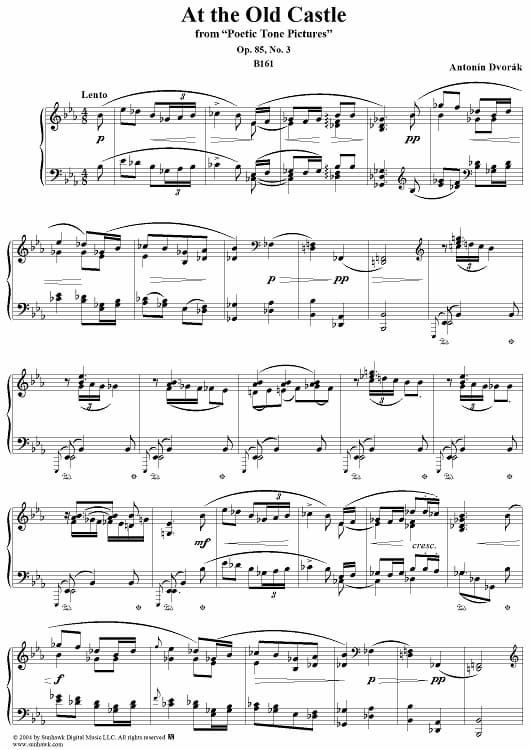
Dvořák: Poetic Tone Pictures, Op. 85 No. 3 “In the Old Castle”
Spring Song
Scored in the pastoral key of E Major, the “Spring Song” features a singing melody gracefully soaring over arpeggiated chords in the left hand. Evoking a gentle breeze, the pastoral modulations radiate the hope and renewal of spring.
The lyrical outer sections and a more animated middle part create a balanced arc, and the warm diatonic progressions create a sense of clarity and optimism. Composed in the manner of Schumann, the “Spring Song” occupies a peaceful and energetic place.
Antonín Dvořák: Poetic Tone Pictures, Op. 85 No. 4 “Spring Song” (Stefan Veselka, piano)
Peasant Ballad
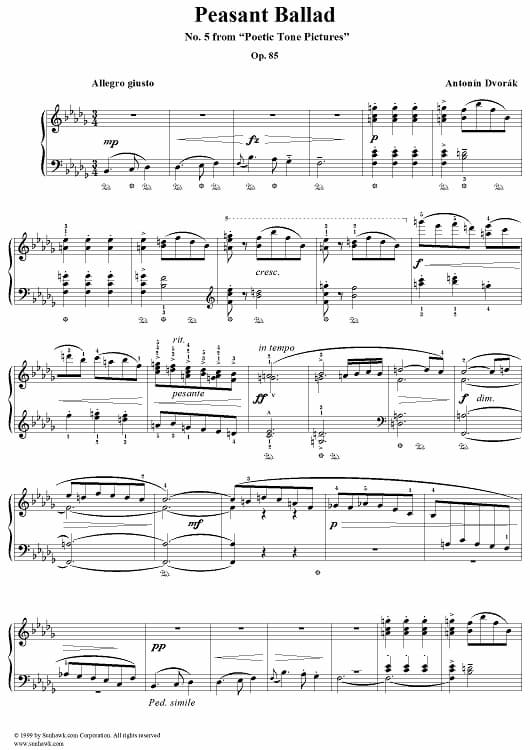
Dvořák: Poetic Tone Pictures, Op. 85 No. 5 “Peasant Ballad”
Through-composed and with a delightful narrative flow, the “Peasant Ballad” feels like an unfolding story. Cast in the minor key with occasional shifts to the Major, this miniature is thoroughly grounded in the folk style.
A robust, folk-inspired melody is supported by a steady rhythmic accompaniment and bold octave passages in the bass. Modal harmonies provide a rustic flavour, and the strong duple meter gives this miniature the pulse of a ballad, evoking oral storytelling.
Antonín Dvořák: Poetic Tone Pictures, Op. 85 No. 5 “Peasant Ballad” (Stefan Veselka, piano)
Reverie
Flexible, with plenty of rubato in the slow sections and alternating with a lively 3/4 in the faster ones, “Reverie” unfolds in the famous “Dumka” form. This musical genre identifies a type of instrumental music involving sudden changes from melancholy to exuberance.
An expressive cantabile melody unfolds over a brooding accompaniment, suddenly contrasted by dance-like episodes. This little gem captures the characteristic blend of sorrow and exuberance, creating a powerful emotional journey that ranges from despair to fleeting joy.
Antonín Dvořák: Poetic Tone Pictures, Op. 85 No. 6 “Reverie” (Stefan Veselka, piano)
Furiant
The “Furiant” references a fast Bohemian dance known for its rapid, syncopated rhythms. It often features a combination of 2/4 and 3/4 time signatures with a 3/4 context. It is a lively and energetic dance frequently described as “spirited” or “fiery.”
True to its name, Dvořák composes a spirited folk dance with the syncopated melody driving the accompaniment. He also uses diatonic harmonies with sharp dissonances for rhythmic emphasis. It is a celebratory dance, capturing a wild, communal spirit that conveys confidence and bravado.
Antonín Dvořák: Poetic Tone Pictures, Op. 85 No. 7 “Furiant”
Goblin’s Dance
Whimsical and unsettling, the “Goblin’s Dance” blends humour with a touch of the supernatural. The playful yet eerie melody is subject to sudden dynamic changes that create a sense of mischief and unease.
The mischievous main theme recurs between spooky episodes, and scampering figures with sudden dynamic shifts are used for dramatic effect. In addition, unexpected chromatic shifts sound unsettling, dissonant chords and provide for unexpected modulations.
Antonín Dvořák: Poetic Tone Pictures, Op. 85 No. 8 “Goblin’s Dance” (Daniela Ballek, piano)
Serenade
Lyrical outer sections embrace a more animated middle in the “Serenade.” A singing and what has been called “trivial melody” emerges out of folk-like innocence and is supported by consonant harmonies with subtle chromatic touches.
This melody and a soft dynamic level convey intimacy and affection, while the middle section adds a hint of playful charm. Radiating tender and romantic warmth, this gem provides a sense of quiet devotion. And the middle section, lulling in a siciliano meter, casts a quite memorable expression.
Antonín Dvořák: Poetic Tone Pictures, Op. 85 No. 9 “Serenade” (William Howard, piano)
Bacchanalia
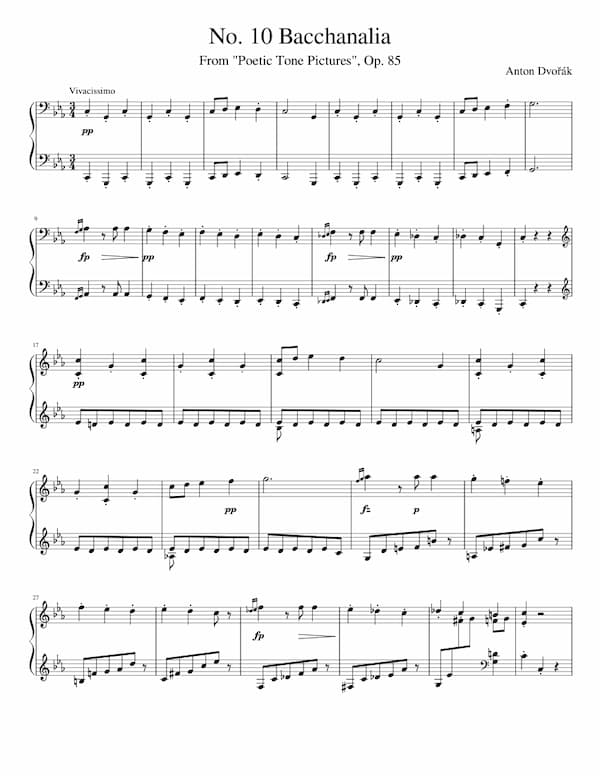
Dvořák: Poetic Tone Pictures, Op. 85 No. 10 “Bacchanalia”
Through-composed and sounding a frenzied and continuous structure, “Bacchanalia” features dense and virtuosic writing with rapid scales, arpeggios and thick chords. The bold and dissonant harmonies sparkle with chromatic intensity, and the relentless rhythm evokes a wild dance.
This miniature captures the unrestrained ecstasy of a Bacchic revelry, sounding chaotic and intoxicating energy. The relentless pace and dramatic dynamics convey abandon and passion, with moments of tension suggesting a darker edge. It all feels exhilarating yet slightly dangerous.
Antonín Dvořák: Poetic Tone Pictures, Op. 85 No. 10 “Bacchanalia” (Daniela Ballek, piano)
Tittle-Tattle
This Rondo-like miniature features a gossipy main theme recurring between contrasting episodes. Light and chatty figures conversationally exchange between hands, and a bright and diatonic harmony provides quirky chromatic twists.
Antonín Dvořák: Poetic Tone Pictures, Op. 85 No. 11 “Tittle-Tattle”
At a Hero’s Grave
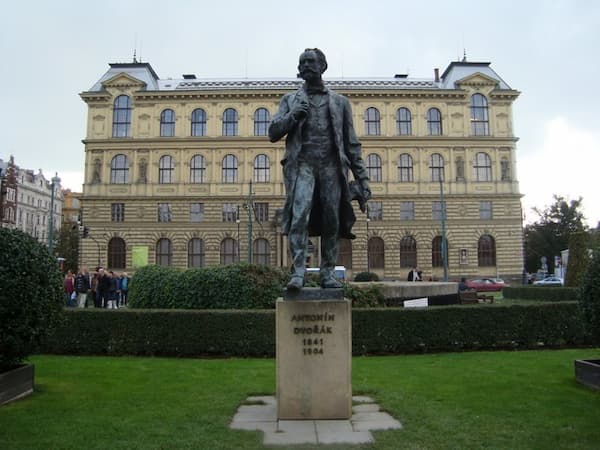
Statue of Antonín Dvořák in Prague
At a Hero’s Grave conveys profound grief and reverence, with sombre chords and a plaintive melody evoking mourning and solemnity.
Antonín Dvořák: Poetic Tone Pictures, Op. 85 No. 12 “At a Hero’s Grave” (Daniela Ballek, piano)
On the Holy Mountain
The concluding On the Holy Mountain evokes a spiritual and transcendent atmosphere. Chorale-like chords illuminate a meditative structure, and this gem provides a fitting close to the set with a message of hope and eternity.
In his Poetic Tone Pictures, Op. 85, Antonín Dvořák offers a deeply personal and evocative journey through thirteen piano miniatures, each a window into his Czech soul and Romantic heart. He weaves folk-inspired melodies, rich harmonies, and vivid imagery, creating a tapestry of human experience. These miniatures are a testament to Dvořák’s gift for storytelling through music, and they invite listeners to linger in deliciously varied moments that resonate long after the final notes have faded away.
For more of the best in classical music, sign up for our E-Newsletter
Antonín Dvořák: Poetic Tone Pictures, Op. 85 No. 13 “On the Holy Mountain” (William Howard, piano)



